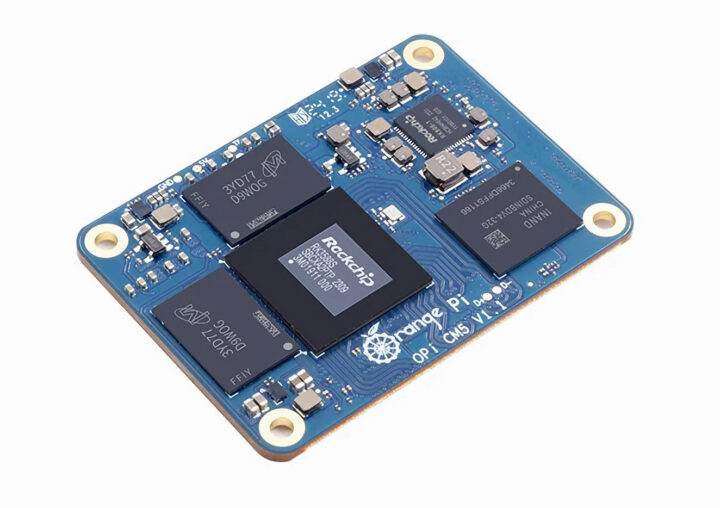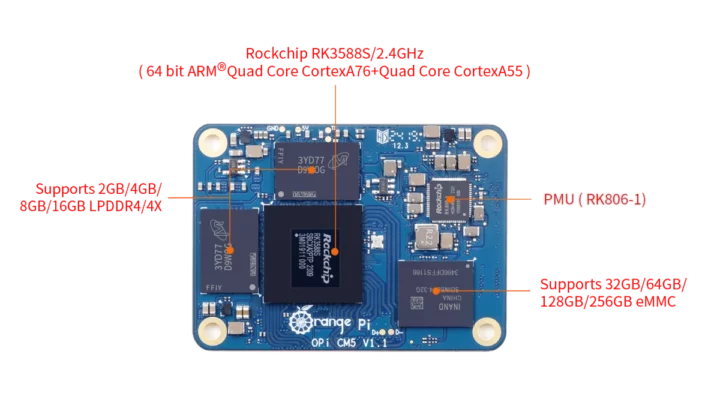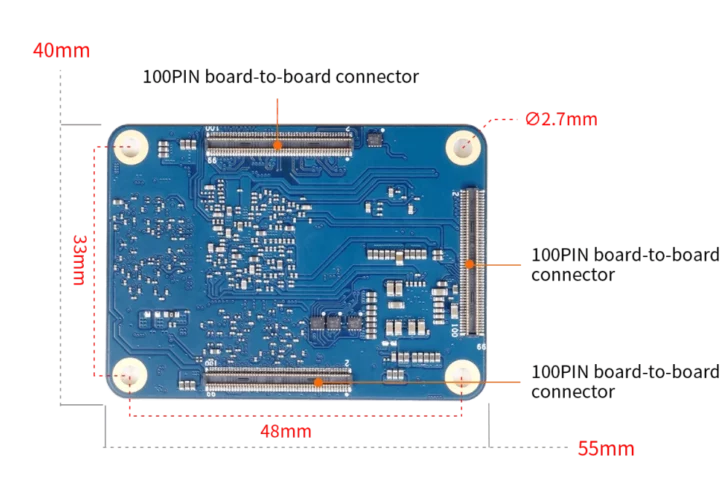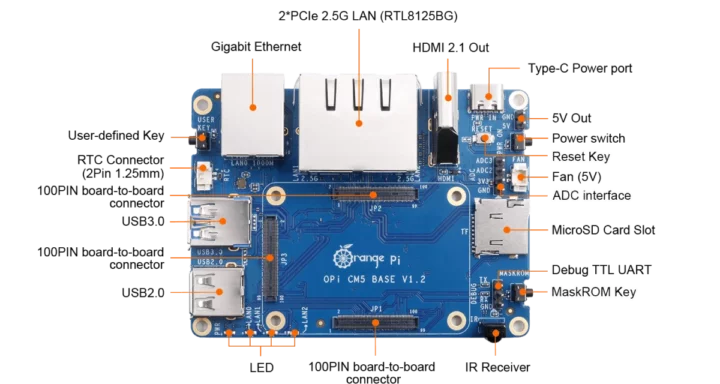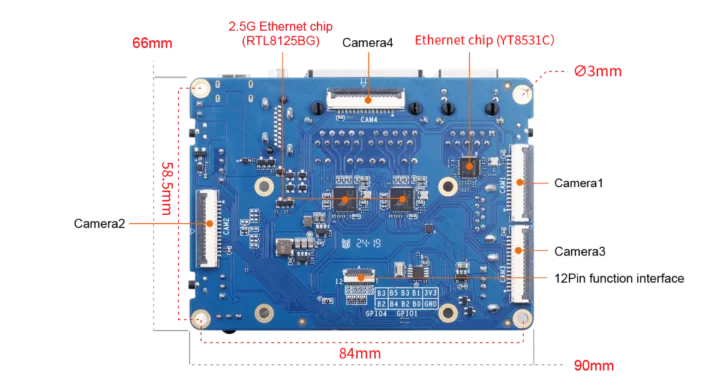Orange Pi CM5 is a system-on-module mostly compatible with the Raspberry Pi CM4 (and upcoming Raspberry Pi CM5?) powered by a Rockchip RK3588S octa-core Cortex-A76/A55 processor that supports up to 16GB LPDDR4 and 256GB eMMC flash compared to the Pi CM4 module that is limited to 8GB RAM and 32GB flash.
Since the Rockchip RK3588S has more interfaces than the Broadcom BCM2711 found in the Raspberry Pi CM4, the company added an extra 100-pin board-to-board connector with extra interfaces such as native USB 3.0, SATA III, CAN Bus, and an additional PCIe 2.0 x1 interface for a total of two.
Orange Pi CM5
Orange Pi CM5 specifications:
- SoC – Rockchip RK3588S octa-core processor with
- 4x CortexA76 cores @ up to 2.4GHz, 4x CortexA55 core @ 1.8GHz
- Arm Mali-G610 MP4 “Odin” GPU with support for OpenGL ES1.1/2.0/3.2, OpenCL 2.2 and Vulkan 1.2
- Video decoder – 8Kp60 H.265, VP9, AVS2, 8Kp30 H.264 AVC/MVC, 4Kp60 AV1, 1080p60 MPEG-2/-1, VC-1, VP8
- Video encoder – 8Kp30 H.265/H.264 video encoder
- AI Accelerator – 6 TOPS NPU
- Process node – 8nm LP
- System Memory – 2GB, 4GB, 8GB, or 16GB LPDDR4x SDRAM
- Storage – 32GB, 64GB, 128GB, or 256GB eMMC flash
- 3x 100-pin 0.4mm pitch DF40 board-to-board connectors
- Storage
- 2x SATA interfaces, one shared with USB 3.0, the other with PCIe 2.0
- SD card support via SDMMC interface
- Video Interfaces
- HDMI 2.1 or eDP 1.3
- 4-lane MIPI DSI interface
- 2-lane MIPI DSI interface
- Camera I/F
- 4-lane MIPI CSI Rx
- 2x 2-lane MIPI DPHY Rx
- Networking – RGMII Gigabit Ethernet (No PHY on module)
- USB – 3x USB 2.0, 1x USB 3.0 Type-C interface with DP 1.4 Alt Mode
- PCIe – Up to 2x PCIe Gen 2 x1 (5Gbps) multiplexed with USB 3.0 or SATA
- Other peripherals
- 1x SDIO 3.0 (e.g. for WiFi 5 and Bluetooth 5.0)
- Audio – I2S, PDM, SPDIF
- UART, I2C, SPI, PWM
- CAN Bus
- 2x ADC
- GPIOs
- Storage
- Power Management – Rockchip RK806-1 PMIC
- Supply Voltage – Single +5V DC input up to 1.8A
- Dimensions – 55 x 40 x 1.6mm (PCB)
- Weight – 12 grams
Orange Pi will offer Orange Pi OS(Arch), Ubuntu, Debian, and Android 12 images on the Download page for the module, along with Linux and Android source code, a user manual, schematics (PDF), tools, and mechanical files. I say “will” because, at the time of writing, all those are listed but point to empty folders on Google Drive.
It’s not the first Raspberry Pi CM4 alternative called “CM5”, as the Radxa CM5 was unveiled in September 2022 and the Cool Pi CM5 with a 314-pim MXM connector followed in April 2023, both with a Rockchip RK3588-based design as the Orange Pi CM5 SoM. The Raspberry Pi CM4 compatibility of the Radxa CM5 and Orange Pi CM5 is limited to mechanical and electrical compatibilities with some limits (e.g. dual HDMI is not supported), and the low-level software for Rockchip RK3588S is different from the one for the Broadcom BCM2711 found in the Raspberry Pi CM4.
Orange Pi CM5 Base Board
Like its competitors, the Orange Pi CM5 should work with the official Raspberry Pi CM4 IO board taking into account the aforementioned limitations, and compatibility with other CM4 carrier boards need to be tested on a case-by-case basis. To make use of the interfaces on the additional 100-pin connector, you’ll need to get the Orange Pi CM5 Base Board.
Orange Pi CM5 Base Board specifications:
- Compatible with the Orange Pi CM5 module described above only.
- Storage – MicroSD card
- Video output – HDMI 2.1 up to 8K @ 60Hz
- Camera – 4x 2-lane MIPI connectors on the bottom side of the board
- Networking
- Gigabit Ethernet RJ45 port via YT8531C transceiver
- 2x 2.5GbE RJ45 ports via Realtek RTL8125BG PCIe controllers
- USB
- 1x USB 3.0 port (Host or Device mode supported)
- 1x USB2.0 port
- Expansion
- 12-pin FPC socket
- Configurable UART, PWM, I2C, SPI, CAN, GPIO, and other functional interfaces
- Supports 3.3V 500mA power output
- 4-pin ADC header with 2x 12-bit ADC inputs up to 1.8V
- 12-pin FPC socket
- Debugging – 3-pin debug serial port (UART)
- Misc
- IR receiver
- 2-pin RTC connector (1.25mm pitch)
- 2-pin 5V fan connector (1.25mm pitch)
- Power on/off key, MASKROM key, user-defined key, reset key
- Red power LED, 3x green LEDs for WAN, LAN1, LAN2
- Power supply – 5V/5A via USB Type-C port
- Dimensions – 90 x 66 mm
- Weight – 57.5 grams
Considering its size, the carrier board is feature-rich but does not provide flexibility. For instance, the SATA or PCIe interfaces are used by the USB 3.0 port and the 2.5GbE controllers, but it might have been a good idea to make a larger board with M.2 socket(s) and SATA ports and configuration with DIP switches to USB 3.0, SATA, or PCIe as per the user needs. A wireless module is also missing from both the module due to size constraints and the carrier board which can take a USB WiFi adapter.
Price and availability
The Orange Pi CM5 SoM and baseboard are currently available on Aliexpress with the following options and prices:
- $70 with 4GB RAM and 32GB eMMC flash
- $90 with 8GB RAM and 32GB eMMC flash
- $119 with 16GB RAM and 32GB eMMC flash
- $20 for the CM5 Base Board
The 256GB eMMC flash option is not available on Aliexpress at this time. European users may need to wait for a few more days before being able to purchase a kit. Orange Pi CM5 modules and kits should also become available on Amazon in the next few days. Additional information may be found on the product pages for the module and carrier board.

Jean-Luc started CNX Software in 2010 as a part-time endeavor, before quitting his job as a software engineering manager, and starting to write daily news, and reviews full time later in 2011.
Support CNX Software! Donate via cryptocurrencies, become a Patron on Patreon, or purchase goods on Amazon or Aliexpress


